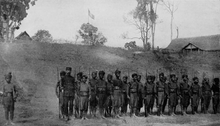French protectorate of Laos
After the surrender of Japan shortly thereafter, the restoration of French control over the country was opposed by the newly established Lao Issara government, who ultimately failed by April 1946.Following Siam's acceptance of the ultimatum, to cede the lands east of the Mekong including its islands, the Protectorate of Laos was officially established and the administrative capital moved from Luang Prabang to Vientiane.Officially, the Kingdom of Luang Prabang remained a protectorate with internal autonomy, but in practice it was controlled by French residents while the rest of Laos was governed as a colony.[14] As late as 1945, the French even drew up an ambitious plan to move massive Vietnamese population to three key areas, i.e. the Vientiane Plain, Savannakhet region, Bolaven Plateau, which was only discarded by Japanese invasion of Indochina.Vietnamese and Chinese merchants also later arrived to repopulate the towns (particularly Vientiane) and revive trade and some Lao Loum were later allowed to participate in local government.[16][17] Between 1899 and 1910, political unrest in the northern Phôngsali Province occurred as local hill tribe chiefs challenged French rule and assimilation policies being carried out in the highlands.[20] Although tin mining and coffee cultivation began in the 1920s, the country's isolation and difficult terrain meant that Laos largely remained economically unviable to the French.Although the French did impose an assimilation program in Laos as in Vietnam, they were slow to fully enforce it due to the isolation and lack of economic importance in the colony.By the 1930s, literacy rates among the Lao Loum and populations in the lowlands had increased considerably and Laotian students began to receive higher education in Hanoi or Paris.However, progress was stagnant in the highlands, where hill tribes were either too isolated to reach or refused to adopt the education system that was based on the foreign French language.With the racial attitudes typical of Europeans at this time, however, they tended to classify the Lao as gentle, amiable, childlike, naïve and lazy, regarding them with what one writer called "a mixture of affection and exasperation".[21] Around October 1940 Thailand, sensing French weakness from the years previous events, began attacking the eastern banks of the Mekong between Vientiane and Champassak Province.[23] Savang Vatthana and Resident-Superior Maurice Roques signed an agreement on 21 August 1941 which attached the provinces of Xiangkhouang and Vientiane to the Kingdom of Luang Prabang, and placed the protectorate on the same footing as Cambodia and Annam.At the same time, Imperial Japanese troops were being largely defeated in the Pacific Front and in a last-minute attempt to draw support Japan dissolved French control over its Indochinese colonies in March 1945.The staunchly pro-French King Sisavang Vong was also imprisoned and forced by the Japanese, and at much urging from Prince Phetsarath, into declaring the French protectorate over his kingdom ended, while entering the nation into the Greater East Asia Co-Prosperity Sphere on 8 April 1945.Prince Phetsarath urged the King to reconsider and sent telegrams to all Laotian provincial governors notifying them that the Japanese surrender did not affect Laos' status as independent and warned them to resist any foreign intervention.On 15 September he declared the unification of the Kingdom of Laos with the southern regions; this caused the King to dismiss him from his post as Prime Minister on 10 October.Katay Don Sasorith, finance minister in the new government, wrote after the war that while the return of the status quo was perhaps desirable to Crown Prince Savang "who had never worked in his life and who had never been concerned with the needs and aspirations of the Lao people" it was a "total misunderstanding of the evolution of our sentiments and views since the Siamese aggression of 1940 and the Japanese action of 1945.Sympathies to all involved factions; French, Thai, Vietnamese, Royal, Nationalist, could be found in Laos and the political situation became extremely confused.In a last desperate attempt to legitimize their government the Lao Issara asked King Sisavang Vong to re-ascend the throne as constitutional monarch, to which he agreed.Elections were held in December for a new Constituent Assembly which met in March 1947 and endorsed a new constitution, giving birth to the Kingdom of Laos on 11 May 1947, still a member of the somewhat reorganized Indochinese Federation.They had conducted small guerrilla raids against the French with the help of the Viet Minh, but after Thailand started shifting towards a pro-French policy in 1947, Lao Issara had to cease their military activities from the country.



Flag(1893–1952)Coat of arms(1949–1953)French IndochinaVientianeLuang PrabangFrenchTheravada BuddhismRoman CatholicismUnitaryabsolute monarchycolonial administrationparliamentaryconstitutional monarchyFrench UnionOun KhamZakarineSisavang VongResident-SuperiorAuguste PaviePrime MinisterPhetsarathSouvanna Phoumarule by decreeParliamentUpper houseLower houseNational AssemblyNew ImperialismProtectorate establishedChampasakLao IssaraKingdom of LaosRecognitionPiastre1893:Kingdom ofLuang PrabangPrincipalityof Phuan1904:Kingdom ofChampasak1904:Kingdomof Siam1946:Kingdom of Laos(Lao Issara)1945:Kingdom of Laos(Japanese puppet)1947:Kingdom of LaosFrench protectorateSoutheast AsiainterregnumJapanesepuppet stateSiamesevassalKingdom of Luang PhrabangFranco-Siamese crisis of 1893Principality of PhuanKingdom of Champasakits KingFrench Governor-GeneralGovernor-General of French IndochinaWorld War IIsurrender of JapanFirst Indochina War1954 Geneva ConferenceCambodiaErnest Doudart de LagréeMekong RiverFrench CambodiaCochinchinaThailandChulalongkornsuzeraintyBlack Flag Armyultimatumdiplomatic crisis took place in 1893Paknam incidentGreat BritainBangkokUnited KingdomBritish Burmathe provinceSainyabuliChampasak ProvincePreah Vihear ProvinceRatsadanayIndochinaBritish EmpireStung Treng ProvinceKontumPleikurice alcoholThakhekSavannakhet regionBolaven PlateauMartin Stuart-FoxLao TheungLao SoungLao Loumhill tribesa revolt broke outOng KeoOng KommandamPhôngsali ProvinceTonkinWar of the InsaneXiangkhouang ProvinceSavannakhetRoute nationale 13tin miningFrench languageFrench School of the Far EastLao languageentered French IndochinaVichy FrenchFrench defeatedGermanyPlaek Phibunsongkhramoverthrew the kingmilitary dictatorshipTai peoplesChampassak ProvinceThai invasionnaval victory at Ko ChangSavang Vatthanaroyal house of ChampasakGovernor-General of IndochinaJean DecouxLan XangPhnom PenhKingdom of Luang Prabang (Japanese puppet state)liberation of Paris